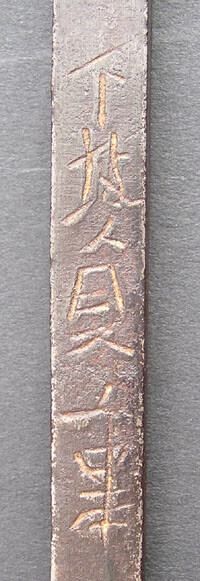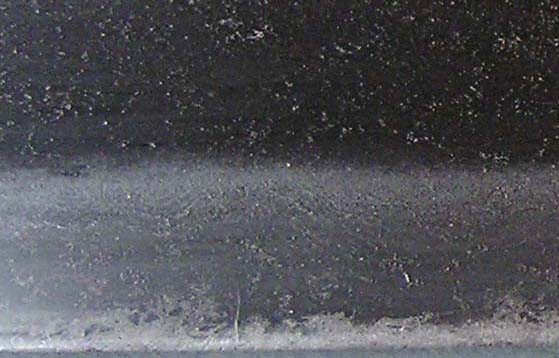
Jeff Pringle
Members-
Posts
12 -
Joined
-
Last visited
Everything posted by Jeff Pringle
-
This has me stumped, digging around the kanji sites etc. it looks like this reads ko- something katsu-something, the only kanji that looks anything like number two to me is mori, but komori doesn't sound like a name....any help would be much appreciated. The sword is in bad shape, given to a friend's grandfather upon graduation from a military academy in Korea..early forties. Thanks a bunch! Jeff
-
I advise you to consider the angle of reflection, and the background that your subject that is reflecting...That's all I can say for now!
-
Thanks for the help so far! Sadashige-san does not have a very big web presence, so I have not been able to find much info. A light polish and it looks like this, I think I can reveal the jihada with a little more work, but you can kinda tell what’s going on by the distribution of the ji-nie:
-
That list is only iron meteorites – there are 66 meteorites total, including 12 “unapprovedâ€, which are probably not meteorites but were mentioned as such in scientific or other literature in the past. Most meteorites are stones (not forgeable), and most iron meteorites are found on the ground, not seen falling – less spectacular, not as noteworthy – but three of the 10 irons are listed as falls, that’s more than I expected. Japan’s long history of good note-taking is represented in meteorites by Nogata, the world’s first recorded meteorite fall in 861, which the Suga Shrine still has in a box – there does seem to be a bias towards enshrining rather than using, at least with witnessed falls. Nickel does have the effect of increasing hardenability, so that the metal under the clay will be more inclined to harden during the quench resulting in a loss of that dramatic shift from hard to soft steel we call hamon. Assuming you are mixing the meteorite steel with higher-carbon steel to get to a good carbon content for hamon, the nickel percentage should be low enough to control it’s effect on hardenability by over-refining the grain size prior to the quench; say through 5 or 6 nomalizing cycles – not overheating during the normalizing will be important, so use a pyrometer. “Star Shrines†are apparently common in Japan: http://www2.gol.com/users/stever/starshrn.htm Japanese legends about stars/meteorites? http://astro.ysc.go.jp/izumo/den_all_old.html Link to all Japanese meteorites list: http://tin.er.usgs.gov/meteor/metbull.p ... dr=&page=1 Jeff Swordsmith
-
V. F. Buchwald (the guy who literally wrote The Book on Iron meteorites) has a chapter on man & meteoric iron (starts on page 13 of “Iron and Steel in Ancient Timesâ€) - http://books.google.com/books?id=c947L8YJerUC Nothing from Japan, but does mention the meteoric-bladed China items, the alleged keris meteorite and lots more. The citation for the Chinese artifacts is: Gettens, R. J., Clarke, R. S. & Chase, W. T. 1971: “Two Early Chinese Bronze Weapons with Meteoric Iron Blades†Freer Gallery of Art, Occasional Papers 4, No. 1: 1-77 Searching for meteorite or meteoric iron with various sword terms in English and in Kanji results in zilch (except ‘Simple Search ( 隕石 é› )’ results in ‘ç«å±± 体験ã§é›ãˆã‚‰ã‚Œã‚‹è¤‡é›‘ç³»ç½å®³--有ç å™´ç«ã«æ€ã†â€™ - not sword-, but disaster-related?) here: http://ci.nii.ac.jp/en? Black sand = Magnetite, an iron oxide, plentiful wherever granite mountains are eroding away, high return on the mineral-to-metal equation, well-understood, predictable and controllable in smelting. Much preferable (I would think) for forging high-stress objects like swords; a sword smith might think twice about using random lump of strange metal that cropped up under someone’s plow (the un-romantic way most meteorites are found ) for such a critical item. Meteoric iron usually contains 5-20 % nickel, that and the 4-8% cobalt would render all but the extreme low end of the alloy percentages very annoying to work compared to charcoal-smelted ore. Fortunately, many of the high-mass meteorites are on the low-nickel end, it makes acquiring & forging meteoric iron possible these days despite the incredible rarity of the material; back before fast and easy world travel and ebay it is highly unlikely that more than a handful of people were exposed to the material on any one continent (except for them Greenland Inuit who lucked out) – and why turn such a great anvil into a questionable sword, I wonder? :? There are lots of meteorites hitting the atmosphere, but not so many irons – 4% of falls are iron, but they are so obvious to inquisitive humans they represent 40% of the recorded meteorite finds, the other types look an awful lot like the rocks they are. And of the tons that hit the atmosphere, virtually none are findable/recoverable/sizeable enough to do anything with if recovered. For instance, in the last decade, professional teams of scientists as well as professional meteorite poachers have searched the plateaus of Oman for meteorites (second only to Antarctica for ideal meteorite recovery conditions), and recovered one eight-kilo iron – out of many thousands of other meteorites of all types recovered. 12 meteorites from the planet Mars totaling 12 + kilos, one lousy iron. The proto-Omani used up the meteoric iron supply a few thousand years ago. A random mediaeval swordsmith hoping to use meteoric iron, searching in a temperate, forested clime like Japan would certainly die of old age before running across one big enough to stub his toe on, let alone big enough to make a sword with! Iron sand is a much safer bet, unless the meteorite is already in your back yard (being used as an anvil :D ). Of all Iron meteorites found in Japan (in recent history, there may have been others but early metalworkers probably used them up long ago like in Oman), only one was big enough to get more than a couple swords out of, Tanokami Mountain. Looks like Chubu got hit with another largeish one (in fragments) at some point, you might want to focus your search to those regions, see if you can find a tang inscription – if they noted the use of imported iron on nakago, you’d think meteoric would also get written down, no? However I suspect there would have been a more recent article written if something as obvious as an inscription were extant. Check the shrines, they might have something hidden away. All Japanese Iron Meteorites in the Meteoritical Society database: Fukue 1849 Kyushu, Japan Iron 7.3 g Komagome 1926 Kanto, Japan Iron 238 g Kuga 1950 or 1938 Chugoku, Japan IIIAB 5.6 kg Okano 1904 Kinki, Japan IIAB 4.74 kg Sakauchi 1913 Chubu, Japan Iron 4.18 kg Saotome 1892 Chubu, Japan IVA 10.88 kg Shirahagi 1890 Chubu, Japan IVA 22.7 kg Suwa 1915 Chubu, Japan Iron 203 g Tanokami Mountain 1885 Kinki, Japan IIIE 174 kg Tendo 1910 Tohoku, Japan IIIAB 10.1 kg Link for above list: http://tin.er.usgs.gov/meteor/metbull.p ... dr=&page=0 If you visit the database, be sure to look up Black Rock 001, the first meteorite I recovered & managed to get written up – good name for a meteorite! Jeff Swordsmith
-
I’ve always wanted one of these yari, so I grabbed this one. It was sold as “Shimosaka Sadashige†and I wanted to ask for your help in determining if that is accurate, and ask if anyone knows anything more about the smith. From the kanji pages it seems like the characters are these, is that right? 下總 Shimosa 貞 Sada é‡ Shige, Nobu
-
Before acceding to it being completely off-topic, I’d like to point out that the Telegu word that was later Anglicized to ‘wootz’ just meant generic ‘steel’; 'wootz = a particular type of ultra-high carbon steel' is a modern convention. …And one of Yasutsugu’s Nanban-tetsu swords recently was on the block in NY: http://www.christies.com/LotFinder/lot_ ... ID=5047257 SALE 1978, 18 March 2008 Japanese & KOREAN ART LOT 380 A Yasutsugu Katana in Mounts and a Yasunaga Katana in Mounts Edo period (17th century), the first signed Yasutsugu motte Nanban tetsu oite Bushu Edo saku kore and with chrysanthemum crest, the second signed Kawachi no kami Minamoto Yasunaga The first: Sugata [configuration]: naginata-zukuri Kitae [forging pattern]: ko-itame mixed with mokume in ji-nie Hamon [tempering pattern]: gunome-midare in nie with ko-ashi, chikei, ara-nie and uchinoke Boshi [tip]: midare-komi Horimono [carving]: Buddhist ken on the omote; naginata-hi on the ura Nakago [tang]: ubu with o-sujikai file marks and one hole Nagasa [length from tip to beginning of tang]: 27 7/8in. (71cm.) Motohaba [width at start of tempered edge]: 1 3/8in. (3.4cm.) Sakihaba [width before tip]: 1¼in. (2.7cm.) Habaki [collar]: single, gold In shirasaya [wood storage scabbard] Koshirae [set of mounts]: comprising a red, black and grey-lacquer saya finished on the surface with cloud patterns, the saya hardware including kojiri, seme-gane, kuri-gata all iron with shakudo and gold dragons in clouds, the tsuka wrapper with blue silk and mounted with iron fuchi-gashira carved with a wood pattern and decorated with shogi game pieces in gold hira-zogan, the menuki gold dragons, the iron mokko tsuba with a heavy raised rim decorated with clouds and waves in gold nunome and carved on the web with clouds in shishiai-bori, signed Toryu Masahisa koku and kao
-
Many thanks!
-
Well, I've had a go at this via the Nihonto kanji pages as well as some of the fonts on my computer, and gotten nowhere - maybe not the best choice for a first attempt at reading an inscription in Japanese... Thanks for any assistance! Jeff
-
Hey, Murph – Same workshop for sure, too bad the photos are not a little crisper. The chiseling seems washed out/rounded off on the ebay pair, making them look like they’ve been aggressively refinished – which might explain the different size stripes? How much did they fetch, if it is not impolite to ask? Franco – Could you elaborate on how the ji can indicate exposure to high heat/re-tempering? I looked into the steel close to the hamachi and found more of a mokume grain, but did not have time to really get a clear window polished. What I have seen so far makes me think the blade deserves a real polish…there is some interesting stuff going on in the steel. Jeff
-
Thanks for all the input! The tsuka is missing the kashira, and the black ito was disintegrating, but it has both mekugi ana and extends about 10 cm beyond the second one. The end of the wood looks like it was shaped for a regular kashira. The photo of the hamon might be misleading, since I didn’t try to get to the bottom of the pitting there is a lot of noise – I will see if there is a better place to polish a window, and get a better photo this weekend. I’ll try to get a better-lit overall shot, and see if I can capture the boshi as well. The sugata is what caught my eye initially, the strong lines and a dynamic taper to the kasane that really appeals to the swordsmith in me. I was looking for a good example of tiger-motif tosogu, so the combination of interesting shape and well-chiseled tiger menuki convinced me to acquire the blade.
-
Greetings, Nice forum you have here! This tachi blade was attached to a pair of nice menuki I recently found at an estate sale, and I’d like some opinions on its age (gendaito or shinshinto?), school, etc. The blade had been rusted and then cleaned with a scotchbright pad so most details are obscured (at least they left the tang alone!), but it is made in the traditional way, jigane is a very low-contrast masame in the small section I checked. I’m thinking Shinshinto Yamato school working in a Nanbokucho style, does that seem accurate? Nagasa: 77.6 cm Nakago: 28.7 cm











